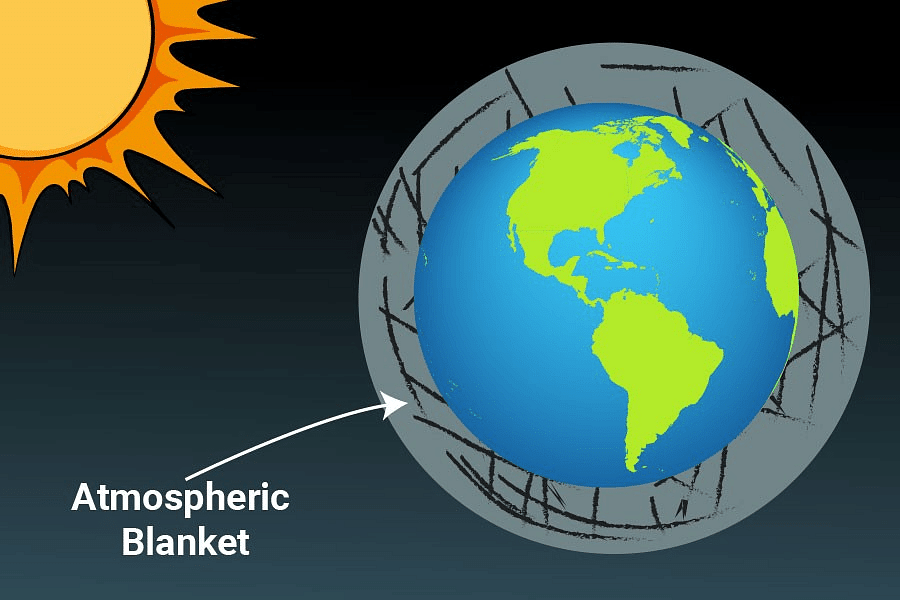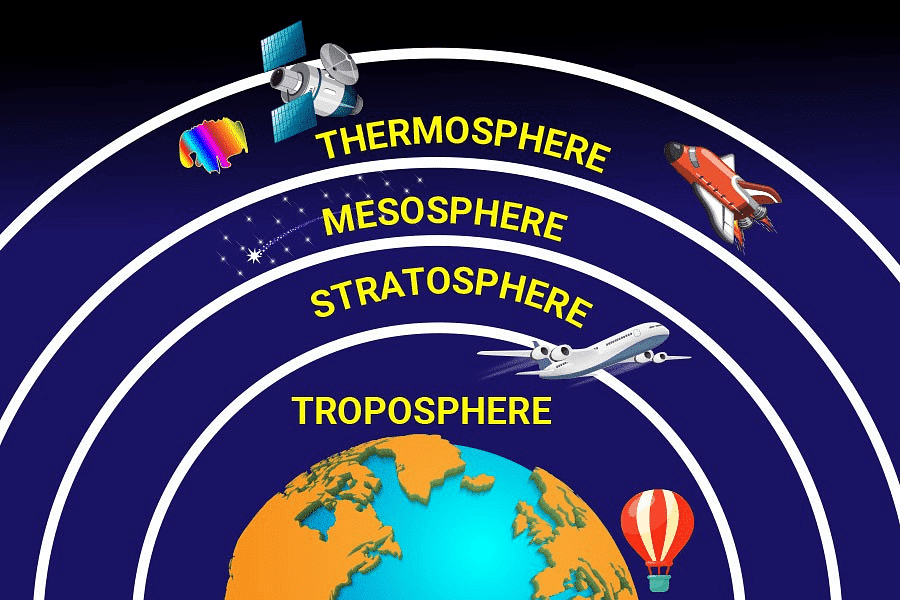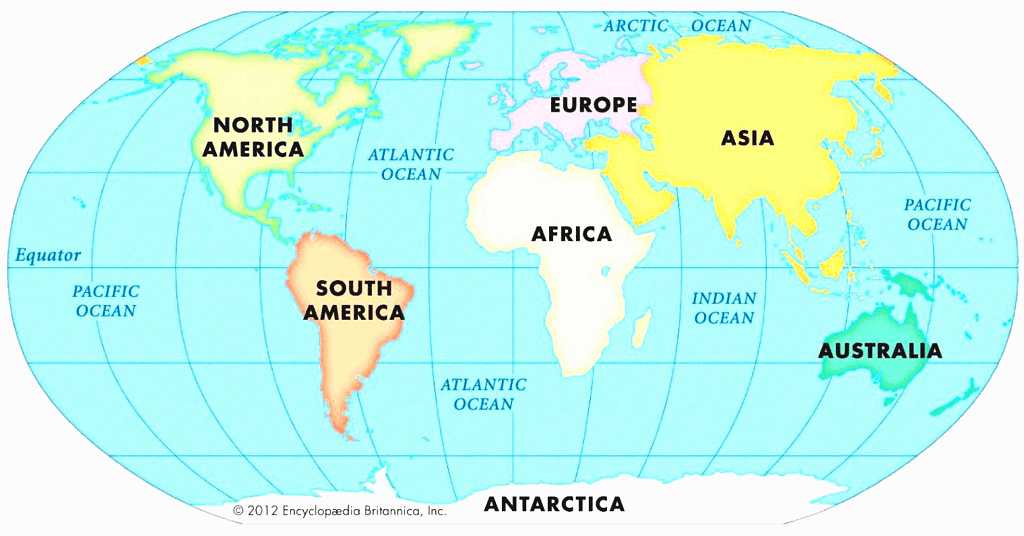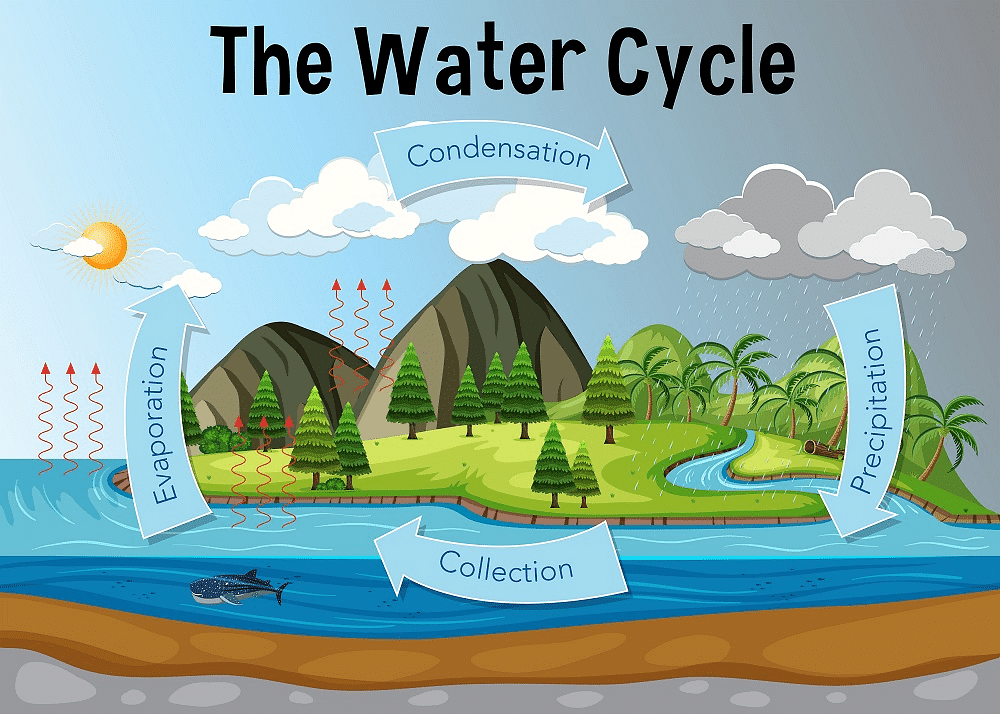Class 6 Geography Chapter 5 Question Answers - Major Domains of the Earth
Short Question & Answers :
Q1: Why is the Northern Hemisphere called the land Hemisphere?
Ans: The Northern Hemisphere is called the land hemisphere because the greater part of continental landmass lies in the northern hemisphere while on the other hand a large percentage of the area in the southern hemisphere is covered with oceans.
Q2: How does the atmosphere act as a blanket?
Ans: Atmosphere acts as a blanket of the earth because it maintains a fairly even temperature both during day and night. The atmosphere also shields the earth from the strong ultraviolet rays of the sun due to the presence of ozone gas. It also protects the earth from meteors.

Q3: Mention the layers of the atmosphere. Name the closest layer to the earth's surface?
Ans: The different layers of the atmosphere are:
1. Troposphere
2. Stratosphere
3. Mesosphere
4. Thermosphere
5. Exosphere
The closest layer to the earth's surface is the Troposphere.

Q4: Name the major oceans on the earth.
Ans: The major oceans on the earth are:
Pacific Ocean, Atlantic Ocean, Indian Ocean, Arctic Ocean and the Southern Ocean. In 2000, the International Hydrographic Organization created the Southern Ocean extends from the coast of Antarctica north to 60 degrees south latitude with an area of approximately 20.3 million square kilometres.
Q5: What do you mean by Strait? Name the Strait between India and Sri Lanka.
Ans: A strait is a narrow passage of water connecting two large water bodies like seas and oceans. The strait between India and Sri Lanka is Palk Strait.
Q6: What is a plateau? Name the two important plateaus of the world.
Ans: A plateau is a large area of fairly level land rising much above the surrounding areas. A plateau may have steep slopes on one or more sides. The height of the plateau may range from 400 meters to several thousand meters above sea level. These are almost flat. Deccan Plateau of India and the plateau of Africa are two important examples.
Q7: Why do climbers often experience breathing problems?
Ans: The climbers experience problems in breathing due to a decrease in the density of air. They have to carry with them oxygen cylinders to be able to breathe at higher altitude as the density of air keeps on decreasing with an increase in altitude.
Q8: What are mountains?
Ans: A mountain is a conical mass of land rising to a much greater height than the surrounding areas. Its uppermost projected area is called the peak.
Q9: How do old and young mountains differ?
Ans: Old mountains have rounded features and are low in height such as Aravallis. It is because they are very old and have been eroded by the forces of nature like wind, water, etc. over a long period. Young mountains have conical features and are greater in height. The best example of young folded mountains in the Himalayas.
Q10: Name the major continents of the earth. Which is the largest continent?
Ans : The major continents of the earth are:
- Asia
- Europe
- North America
- South America
- Africa
- Australia
- Antarctica
The largest continent is Asia.
 Continents and Ocean of the World
Continents and Ocean of the World
Q11: What are the important constituents of the atmosphere?
Ans : The major constituents of the atmosphere are:
- Gases
- Water Vapour
- Dust Particles
The pure dry air is composed of five main gases:

Q12: The three domains of the earth interact with each other and affect each other in some way. Discuss.
Ans: The three domains of the earth interact with each other and affect each other. For example, industrial effluents are thrown on the land from where they gradually flow into rivers, lakes and other water bodies. Hence, polluting both land and water. The polluted release of smoke and other gases further pollute the atmosphere. So, all the major domains are affected by one common source.
Q13: Write a short note on Antarctica.
Ans: Antarctica lies completely in the southern hemisphere. At the centre of the continent is the South Pole. It is permanently covered with thick ice sheets. There are no permanent human settlements here. Many countries have set up their research station here. Maitri and Dakshin Gangotri are Indian research centres.
Q14: Inspite of being called the Blue Planet, the earth experiences shortage of water. Why?
Ans: The earth experiences water shortage because 97% of the earth’s water is found in the oceans and is too salty for human use. Of the remaining 3%, a large proportion is in the form of ice sheets, glaciers and under the ground. A very small percentage is available as freshwater.
Q15: What are the various uses of oceans?
Ans: Ocean currents greatly affect the Earth's climate by transferring heat from the tropics to the Polar Regions, and transferring warm or cold air and precipitation to coastal regions, where winds may carry them inland. The oceans are essential for transportation: Most of the world's goods are exported or imported by ship between the different continents. Oceans are also the major supply source for the fishing industry Offshore Oil, Gas and Mining Recreation and Tourism: Including fishing, boating, swimming etc. Disposal of Waste from Land: Including sewage, non-point sources, CO2 sink.
Q16: How do we measure the elevation of land?
Ans: The level of seawater remains the same everywhere. The elevation of the land is measured from the level of the sea, which is taken as zero.
Q17: Describe the water cycle.

Ans: The continuous changes of the state and movement of water throughout the Earth system, i.e., the atmosphere, biosphere, lithosphere and hydrosphere is known as the water cycle. The water cycle is driven by energy from the Sun rays, which cause liquid water from Earth's surface to change into gas in a process called evaporation. As the gaseous vapour rises and circulates in the atmosphere, it cools and changes back into a liquid, a process known as condensation. When water vapour condenses, tiny droplets form clouds, which return the water to Earth as precipitation.
Q18: Write a note on the exosphere.
Ans: The outermost layer of Earth's atmosphere extends upward. Here, the particles are so far apart, that they can travel hundreds of km without colliding with one another. Since the particles rarely collide, the atmosphere no longer behaves like a fluid. These free-moving particles follow ballistic trajectories and may migrate into and out of the magnetosphere or the solar wind. The exosphere is mainly composed of hydrogen and helium.
Q19: What is acid rain?
Ans: Rainwater is naturally acidic due to carbon dioxide, which partially reacts with water to give carbonic acid. When we talk about acid rain, we mean the enhanced effect that is caused by other gases released when fossil fuels are burnt. Two main gases are: Sulphur dioxide and Nitrogen oxide. The dilute acid falls to the ground as acid rain.
Q20: What is ozone depletion?
Ans: Ozone depletion occurs when the natural balance between the production and destruction of stratospheric ozone is tipped. Although natural phenomena can cause temporary ozone losses, man-made synthetic compounds such as CFCs are now accepted as the main cause of this depletion. Ozone depletion, in fact, is occurring all over the world due to man-made pollution, at 19 to 30 km above the Earth's surface. However, in certain parts of the world, ozone depletion is particularly severe.
Long Question Answers:
Q1: Why is the Biosphere important for the living organism?
Ans: The biosphere is the zone where life exists. This is the sphere where the other three spheres i.e. Lithosphere, Hydrosphere and atmosphere interact with each other. In this zone life, that is unique to this planet, exists. All living organisms including human beings are dependent on this sphere for survival.
Q2: Define global warming. State the factors responsible for it.
Ans : Global warming is the increased average temperature of the Earth's near-surface air and oceans.
- The most prominent factor is the combustion of fossil fuels in cars, factories and electricity production. They produce carbon dioxide, which is the most common gas responsible for global warming.
- Other contributors include methane released from landfills and fertilizers.
- Gases used for refrigeration and industrial processes.
- The loss of forests that would otherwise store CO2.
Q3: What are the major effects of water pollution?
Ans : The major effects of water pollution are:
- The food chain is damaged. When toxins are in the water, the toxins travel from the water to the animals and to humans when the animal's meat is eaten.
- Diseases can spread via polluted water. Infectious diseases such as typhoid and cholera can be prevented from drinking contaminated water.
- Acid rain contains sulfate particles, which can harm fish or plant life in lakes and rivers.
- Pollutants in the water will alter the overall chemistry of the water, causing changes in acidity, temperature and conductivity. These factors all have an effect on marine life.
- Marine food sources are contaminated or eliminated by water pollution.
- Altered water temperatures (due to human actions) can kill marine life and affect the delicate ecological balance in bodies of water, especially lakes and rivers.
Q4: How are human beings disturbing the balance of nature?
Ans: Human beings have got certain needs and with these, they also have certain abilities; physical as well as mental. Thus in order to fulfill their needs, human beings are continuously using their abilities to modify nature. But with the advancement in technology, this modification of nature has taken the shape of degradation and exploitation of nature. There is thus, a need to limit the use of resources of the earth to maintain the balance of nature between the domains of the lithosphere, the atmosphere, and the hydrosphere.
|
69 videos|386 docs|80 tests
|
FAQs on Class 6 Geography Chapter 5 Question Answers - Major Domains of the Earth
| 1. What are the major domains of the Earth? |  |
| 2. How do the lithosphere and hydrosphere interact? |  |
| 3. What is the importance of the atmosphere for life on Earth? |  |
| 4. How does the biosphere depend on the other domains? |  |
| 5. What are some examples of how human activities affect the Earth's domains? |  |























